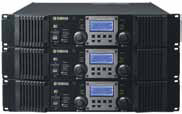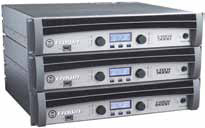Power To The Profits

Loudspeaker Trends Bundle Better Sound With Installation Ease
Almost across the board, speaker manufacturers are responding to market demand with compact, powerful systems that are not just easier for customers to operate but also offer integrators a variety of cost savings.
“With so much DSP and amplifier technology being integrated into the average speaker box, the question is how to make things easier for the integrator and the customer,” considered Phil Sanchez, product manager for QSC Audio. “There’s clearly a trend to make these systems much simpler, much easier to use.”
On the portable side, he continued, “Powered loudspeakers are a big trend. It’s a lot less gear to carry.”
There is also a trend to get more into smaller boxes, he noted. “Some of that is due to the DSP that you can throw into the box to help get the maximum out of a driver or correct some things that weren’t maybe as easy to correct before, especially if it’s a powered loudspeaker.”
Customer expectations are also likely driving new designs. “People hear great sounding stereos at home, in their cars, at the movies, so they want that same experience in their office setting, their retail store, or wherever,” Sanchez said.
James “Buck” Waller, CEO for ISP Technologies, certainly strives to optimize performance. “Where others have two-way systems we have three-way; where other high-end boxes are three-way, ours are fourway,” he said. ISP has patent applications pending for the industry’s first true four-way system, he reported, with a single line array box handling from 90 Hz or 100 Hz out to around 20 kHz.
A daily selection of the top stories for AV integrators, resellers and consultants. Sign up below.
The efficiencies afforded by ISP ’s horn-loaded designs and power amp technology in general represent savings for integrators, Waller pointed out. “We can deliver more SPL per kilowatt of power off the line than any other system out there.”
A powered box means less installation time, too. “The contractor gets his hang points in place, plugs the speakers in, he’s done.” The use of Ethercon connectors on certain models, with low-, mid-, and high-band signals fed down a single cable, are another cost saver, according to Waller.
“Without question we have been driven by certain applications,” he continued, pointing to the smaller format 2208, which will debut at the 2011 NAMM Show this month in Anaheim, CA. “We’ve had many of our contractors say they have specific church designs where our small-format three-way box, the 3112, is just physically too large, but they have a desire to still have a line array performance.”
The Italian brand K-array, distributed in North America by Sennheiser, has taken compact form factors to the extreme. Sennheiser area sales manager Michael Hill reported that the Concert series line arrays offer a performance that belies their size, and provide significant cost savings.
For example, he said, the company recommends that two KH 4 mid/high units, which are about the size of a plasma television and six inches deep, be paired with a single KS 4 low frequency unit, of the same dimensions, which fit into one road case. “If you have two road cases plus two subs you can comfortably do four to 5,000 people and put it in a Sprinter van. Your truck pack is considerably smaller, and your labor in hanging, and liability, of course, is reduced.”
Mike O’Neill, head engineer at Nashville’s One Systems, has brought 35 years of design experience to a line of products aimed directly at outdoor applications and indoor, high ambient noise environments. With outdoor venues presenting more elaborate productions before and during featured events, much higher fidelity is demanded of the speakers these days, he said. “It’s not just voice paging any more.”
One Systems focuses on direct radiator designs that incorporate larger voice coils, larger compression drivers and much higher power handling than historical outdoor horn products. “The cost per watt of an amplifier is almost free these days,” O’Neill observed. “So I don’t worry about efficiency, I worry about bandwidth and intelligibility.”
But One Systems’ products are certainly efficient for integrators: “If you give them a full bandwidth system they only have to hang one box instead of a horn and a horn, and a horn, and then a sub to go with it.” Once in place, the boxes tend to sell themselves, O’Neill added. “If it’s a sports venue, 50 percent of the sales come from the opposing team!”
- Margin Builder
- There are various factors that allow integrators to increase profits in loudspeaker sales, according to QSC Audio’s Phil Sanchez. “If the products are easier to install then obviously it requires less labor. That leads to better margins, and better profits for the integrator. Related to that, if they’re getting better margins or profits, that opens the door for the integrator to hire some new expertise. Maybe he was only doing a certain type of install; if he has a little bit more money it’s an opportunity for him to grow the business and get into new areas by hiring some new talent to help expand.”
Steve Harvey (psnpost@nbmedia.com) has been west coast editor for Pro Sound News since 2000 and also contributes to TV Technology and Pro Audio Review.
Electro-Voice CPS8.5
The CPS8.5 is an eightchannel model featuring Class-D technology for maximum amp efficiency. The CPS8.5’s direct-drive design allows for switchable output characteristics from Low-Z to Hi-Z for each individual channel, ranging from a two-ohm load up to 100-V line drive. In addition, channels can be bridged to double output power. A module slot for the optional RCM-810 remote control module provides control network functionality, allowing for remote system diagnostics via IRIS-Net software as well as Variable Load Drive.
Yamaha TXn Series

The Yamaha Commercial Audio Systems TXn Series amplifiers offer Yamaha on-board DSP power and incorporate a 24-bit 96-kHz DSP engine that enables a range of control and processing capabilities. The three models deliver 2,200 watts, 2,500 watts, and 3,000 watts per channel into two ohms. A key element is the EEEngine technology that provides the sonic quality of Class AB amplifiers with the efficiency of Class D, solving all the problems of weight, size, and heat generation that users of large-output power amplifiers often encounter.
Crest Audio CV-20
Crest Audio’s new CV-20 provides complete flexibility for any Live sound application. Full-VCA control is provided, not only on input channels but also on group masters and L/R and Mono masters for maximum control of complex mixes. Four band sweep able EQ with Q control on the mids and a variable High Pass Filter are provided on all mono inputs. 12 auxiliary sends and eight sub groups are standard on all CV 20 models with fader reverse functionality for easy use as a monitor console.
Lab.gruppen PLM 20000Q

Lab.gruppen’s PLM 20000Q integrates two full-featured modules of Lake Processing with four channels of power amplification, each rated at 5000 watts output. Everything is housed in a 2U chassis weighing 37 pounds, the PLM 20000Q affords power density for even greater utility in all types of sound reinforcement applications. Combining power with Lake loudspeaker processing, the PLM 20000Q is singularly capable of driving many loudspeaker systems or arrays.
Crown I-Tech HD

I-Tech HD features a new DSP engine and linear phase FIR filters together with Crown’s Class-I amplifier technology, as well as a choice of input options including CobraNet and three linked limiters. The next generation DSP engine, BSS OmniDriveHD, at the heart of I-Tech HD is built on a new architecture specifically optimized for fast and efficient audio processing to provide tour and contracting professionals with a new platform for signal processing.
QSC CMX Series

The CMX Series includes Flex- Use loading options allow users to drive low-impedance loads down to two ohms and certain models to drive 70 and 100V distributed loudspeaker systems. Flex-Use Input connectivity choices including actively balanced barrier strip, XLR, or 1/4-inch TRS. Flex-Use output connectivity choices include NL4 Speakon and detachable terminal block rack mountable with chassis less than 16 inches or 40.6 mm deep 1 dB recessed, gain controls for fast, accurate, and repeatable settings, and tamper-proof security cover for gain controls.
